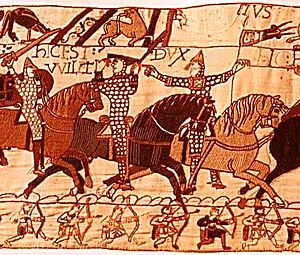Feigned retreat facts for kids
A feigned retreat is a clever trick used in battles. It's when an army pretends to run away from the enemy. They want the enemy to chase them. Then, when the enemy is chasing, the first army suddenly turns around and attacks! This surprise attack is called an ambush.
This tactic can confuse the enemy. It can also make them break their battle lines, making them weaker. Army leaders, called commanders, had to be very careful. They needed to make sure their fake retreat didn't turn into a real one! This trick has been used for thousands of years, even in ancient history, and it's still used today. A famous military writer named Sun Tzu wrote about it in his book The Art of War. He warned people: "When some are seen advancing and some retreating, it is a lure."
Contents
Famous Feigned Retreats in History
Battle of Salamis (480 BC)
At the Battle of Salamis in 480 BC, the Ancient Greeks were fighting a huge sea battle against the Persian navy. The Persian navy was much bigger. The Greek leader, Themistocles, spread a false rumor. He made sure the Persians heard that the Greeks were ready to run away. He hoped the Persians would attack quickly, thinking they would win easily.
This wasn't a real feigned retreat, but it worked like one. The Persians fell for the trick and were defeated.
Battle of Cannae (216 BC)
At the Battle of Cannae in 216 BC, the great general Hannibal used a smart trick against the Roman army. He made the middle of his army look weak on purpose. The Romans saw this and attacked that part of his lines.
As Hannibal's center slowly fell back, the two stronger sides of his Carthaginian army moved in. They surrounded the Romans, who didn't see it coming. For the rest of the day, Hannibal's army trapped and defeated the Romans.
William the Conqueror and the Battle of Hastings
Some stories say that William the Conqueror used feigned retreats at the Battle of Hastings. However, it's very hard to do this trick even once without your army truly running away. It's unlikely he did it twice.
It's more likely that William's soldiers actually broke ranks and started to run away. The Bayeux Tapestry, a famous embroidered cloth, shows William taking off his helmet. The Latin words Hic est dux Wilelmus (here is Duke William) are next to him. This might mean his soldiers thought he was killed. He took off his helmet to show his face and rally his men back into the fight.
Calling it a "feigned retreat" might have been a polite way to say his army ran away and had to be called back. Still, many Anglo-Saxon soldiers were tricked. They chased after William's "retreating" men and were then killed in the counterattack.
Related Battle Tactics
- Flanking maneuver
- Pincer movement (also called a double-envelopment)
- Turning movement
- Ambush
- Envelopment
- Rearguard
- Attrition warfare
- Preemptive war
- Oblique order
- Shock tactics


